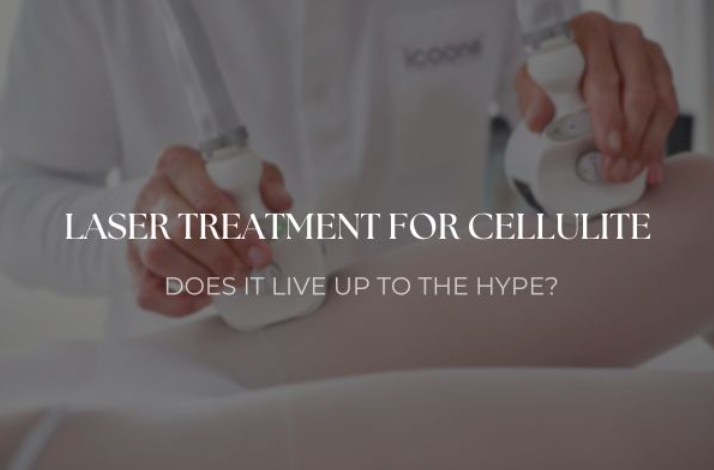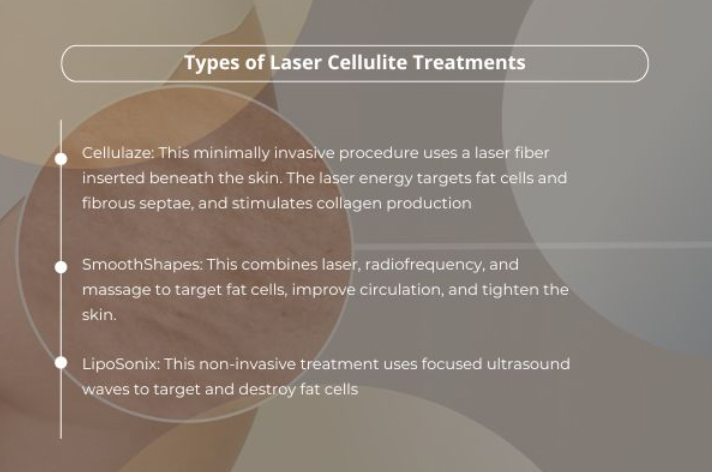Laser Treatment For Cellulite – Does It Live Up To The Hype?

Cellulite. That dreaded word strikes fear into the hearts (and thighs) of many women. Those unsightly bumps and dimples can leave us feeling self-conscious in swimsuits and summer clothes. While genetics play a major role, factors like weight, diet, and exercise can also contribute to its appearance. In our attempt to achieve a smoother, more even complexion, we often turn to the latest trends and treatments. And laser treatment for cellulite has emerged as a popular option.
But before you book that appointment, let’s delve deeper and understand what laser treatment for cellulite entails, its effectiveness, and whether it lives up to the hype.
We believe in empowering women with knowledge. We understand the desire to look and feel your best, but navigating the world of beauty treatments can be overwhelming. That’s why we strive to provide you with honest, evidence-based information so you can make informed decisions about your body.
What is cellulite?
Cellulite is a common condition that causes a lumpy or dimpled appearance on the skin, often on the thighs, buttocks, and hips. It’s caused by a complex interplay of factors, including:
- Fibrous septae: These are connective tissue bands that tether the skin to underlying muscle. When fat cells push against these bands, it creates a bulging effect, resulting in the dimpled appearance.
- Fat cell distribution: Women tend to have a more grid-like collagen structure in their skin compared to men. This grid allows fat cells to protrude more easily, causing cellulite.
- Hormones: Estrogen plays a role in fat storage and circulation. Fluctuations in estrogen levels, such as during pregnancy or menopause, can worsen cellulite.
Understanding Laser Treatment for Cellulite
Laser treatment utilizes laser energy to target the underlying causes of cellulite. Different types of lasers operate with varying mechanisms:
- Ablative lasers: These lasers directly target and destroy fat cells. However, ablative lasers are more aggressive and carry a higher risk of side effects, so their use for the treatment is uncommon.
- Non-ablative lasers: These lasers deliver heat energy to the deeper layers of the skin without damaging the surface. The heat aims to:
- Target fat cells: The heat can potentially damage fat cell membranes, leading to the breakdown of fat.
- Stimulate collagen production: Collagen is a protein that provides skin with structure and firmness. Increased collagen production can lead to a smoother, tighter appearance.
- Break down fibrous septae: Some laser treatments claim to target and loosen the fibrous bands, allowing for a smoother skin surface.
Types of Laser Cellulite Treatments

There are several laser-based technologies used for cellulite treatment, each with its own approach:
- Cellulaze: This minimally invasive procedure uses a laser fiber inserted beneath the skin. The laser energy targets fat cells and fibrous septae, and stimulates collagen production.
- SmoothShapes: This combines laser, radiofrequency, and massage to target fat cells, improve circulation, and tighten the skin.
- LipoSonix: This non-invasive treatment uses focused ultrasound waves to target and destroy fat cells.
Finding Laser Cellulite Treatment Near You
If you’re considering laser treatment, it’s crucial to find a qualified and experienced provider. Here’s what to look for:
- Board-certified dermatologist or plastic surgeon: Ensure your provider has the expertise and training to perform laser treatments safely and effectively.
- Experience with cellulite treatment: Choose a provider who has experience specifically treating cellulite with lasers.
- Consultation: Discuss your goals, expectations, and any underlying health conditions during a consultation. The provider should explain the specific laser technology used, the number of sessions recommended, potential side effects, and expected results.
Elegant Hoopoe – A Word of Caution

While laser treatment for cellulite may offer some improvement, it’s important to manage expectations. Here’s what you need to know:
- Limited evidence: Studies on the effectiveness of laser treatment for cellulite are mixed. Some studies show modest improvements, while others show minimal to no effect.
- Not a permanent solution: Even if you see results, they are likely temporary. Maintaining a healthy lifestyle with a balanced diet and regular exercise is crucial for long-term cellulite management.
- Multiple sessions are required: You likely need multiple treatment sessions to see any improvement, and these can be expensive.
- Side effects: Possible side effects of laser treatment include bruising, swelling, discomfort, and temporary skin irregularities.
Alternative Approaches to Cellulite Management
While laser treatment might not be the magic bullet for cellulite, fret not!
Here are some effective strategies you can incorporate into your lifestyle to manage cellulite and achieve smoother, healthier skin:
- Healthy Diet: Fueling your body with nutritious foods plays a vital role in overall health and can positively impact cellulite appearance. Focus on whole foods like fruits, vegetables, lean proteins, and whole grains. Limit processed foods, sugary drinks, and unhealthy fats, which can contribute to fat storage and inflammation.
- Exercise: Regular physical activity is crucial for managing cellulite. Aim for at least 30 minutes of moderate-intensity exercise most days of the week. Activities like cardio, strength training, and swimming can help improve circulation, promote fat burning, and build muscle tone, all of which can minimize the appearance of cellulite.
- Dry Brushing: This simple practice involves brushing your skin with a dry brush in upward strokes towards your heart. It’s believed to stimulate the lymphatic system, which helps remove toxins and improve circulation, potentially reducing the appearance of cellulite.
- Maintaining a Healthy Weight: While cellulite can occur at any weight, losing weight, especially if you’re overweight or obese, can significantly improve its appearance. Losing weight through a combination of a healthy diet and exercise is the most sustainable approach.
- Topical Treatments: There’s no miracle cream for cellulite, but some topical products containing ingredients like caffeine, retinol, and antioxidants may offer slight improvement. These ingredients can potentially improve circulation, tighten the skin, and promote collagen production. However, results tend to be subtle and require consistent use.
Self-Acceptance and Body Positivity
Cellulite is a normal physiological phenomenon affecting a vast majority of women. It’s important to remember that achieving airbrushed perfection is unrealistic. Embrace your body and its unique features. Celebrate your strength, resilience, and the amazing things your body allows you to do. Here are some tips for cultivating body positivity:
- Focus on what you love: Shift your focus from what you perceive as flaws to what you appreciate about your body. Celebrate your curves, your strength, and your unique features.
- Surround yourself with positive influences: Unfollow unrealistic beauty standards on social media and surround yourself with people who appreciate you for who you are.
- Practice self-compassion: Treat yourself with kindness and understanding. Be gentle with yourself and avoid negative self-talk.
Giving You the Tools for a Holistic Approach
Always believe in a holistic approach to beauty. True beauty radiates from within when you feel confident, healthy, and empowered. While there’s no one-size-fits-all solution for cellulite, the combination of a healthy lifestyle, self-acceptance, and exploring various non-invasive approaches can significantly improve your skin’s appearance and overall well-being.
Remember, you are beautiful, just the way you are. Accept your natural beauty and radiate confidence from within.




